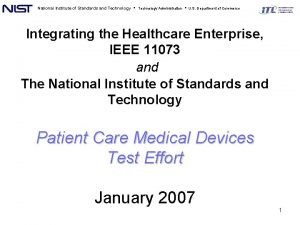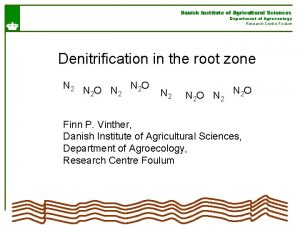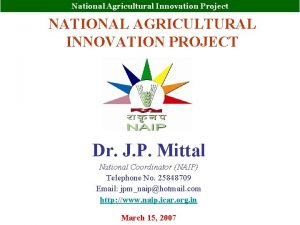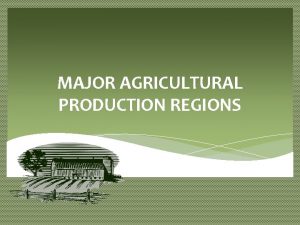National Institute of Agricultural Technology The Institutionalization of


















- Slides: 18

National Institute of Agricultural Technology The Institutionalization of Impact Assessment in Argentina: The National Institute of Agricultural Technology as a Study Case Authors: 1 Gabutti, Silvina Gil, Gabriela Lema, Daniel Mirassou, Susana Morales, Susana Saucede, María Cristina Schain, Diego ARGENTINA - 2005 (1) In alphabetical order

National Institute of Agricultural Technology TOPICS Ø Ø Ø Introduction INTA in the Science & Technology National System : a brief overview The Impact Assessment, some reasons for the non adoption Building on the institutional experience Final Comments

INTRODUCTION Ø Agencies of Science and Technology in Argentina have developed extensive experience in evaluation models to prioritize and to identify technical-academic quality in subsidies for different activities of investigation. Ø A greater focus on techniques of evaluation based on a partial level of study and short term perspectives can be observed. Ø Institutional experiences of the Impact Assessment (IA) from a multidisciplinary approach, of medium–long term and with a global look, are scarce. Ø This paper will attempt to identify reasons to explain the non adoption of these techniques of evaluation at an organizational level, analyzing the scarce institutional stability and government policies under a perspective of transaction costs. Ø Learning from the international experience, we will make recommendations for the institutionalization in an agency of Agricultural Technology.

S&T Public Budget Distribution 2005 (S&T Activities) Source: Budget for S&T Activities. Secretariat of Science and Technology; data from the Ministry of Economy.

Resources destinated to the Science and Technology System and INTA (1998 -2005) Base 1998=100 Source: Budget for S&T Activities. Secretariat of Science and Technology; data from the Ministry of Economy.

INTA in the Science & Technology National System : a brief overview (cont. ) Ø The increased budget for INTA is based on a new policy of strength and institutional development. Included in this policy is a change in the structure of consensus for decision making and in the management model. Ø Advancing in this sense is not a practice proposed by our institution itself, but rather that the evaluation of results and impacts is an incorporated theme in the national agenda. Ø A strategy is being set up at a national level for the methodological development of the Impact Assessment practice.

The Impact assessment, some reasons for the non adoption Some systemic problems related to transaction costs within the organizational structure are: v Contracts Ø Ø v Within a public institution contracts are not made explicitly and among clearly identifiable contractors, they have multiple interacting parties on one side of the relationship (several researchers or teams with interactions) exposed to important contingencies derived from the randomness of research activities. Their terms are generally vague, and leave much room for interpretation and have many loopholes that function as escape clauses. Enforcement Ø Promises made in a research organization are not subject to any external effective enforcement mechanism. If a researcher fails to deliver on such a “contractual obligation” exploiting some excuse (i. e. external negative shocks), the only recourse to the other side is to accept the results and eventually reduce future financing or projects.

The Impact assessment, some reasons for the non adoption (cont. ) n Governance Structures Ø Ø n Governance structures are characterized by various agency relationships. The idea in an agency relationship is that interests of the parties are at least partially in conflict, and the agent has some information or action advantage over the principal. In this structure the informational problems are severe because specific research knowledge is usually only available and understandable by experts. Principals (i. e. managers or directors) in general do not have the opportunity to resort to external advisors to control the agent’s action results and this poses an important problem in the design of an incentive scheme. Bounded Rationality Ø In a research organization individuals´ knowledge is very imperfect. In many cases explicit contract writing, control and enforcement are impossible, because bounded rationality has as serious bite. The extent of the difficulty varies across research areas and times. Some areas with slow rates of innovation or less dynamic environments can have fewer uncertain outcomes and make contracts more feasible.

Building on the institutional experience Ø As of the approval of the Institutional Strategic Plan (ISP) 2005 -2015, a management model was set up in accordance with the new trends in Science and Technology, institutionalizing the impact assessment. Ø The ISP establishes the features for the three-year mid term plans. The reform that is intended to be incorporated aims at promoting greater levels of decentralization, within the framework of a more efficient regionalization and of the strengthening of the social articulation. Ø Within this framework, ISP, for the first time, formalizes and institutionalizes the IA in the agro-industrial, food and agriculture system, in its economic, environmental, social and institutional aspects. Ø This implies: building institutional capacity, developing mechanisms that integrate the information of impact with the process of making decisions.

Programmatic Map ISP 2005 -2015 MTPs Strategic Areas National Programs Specific &Integrated Projects RTPs RCPs

Building on the institutional experience The evaluation of the impact will be made possible relying on the elements of judgment associated with: n n n Accountability; The benefits of the institutional investment in generation and transference of technology; The contribution to the competitiveness of the agro-industrial chains, the sustainability of the productive systems and to the development of the territories; The contribution to the scientific-technological development in the public and private sectors; The generation of information for strategic decision making on the future investments in investigation and development, transference and extension.

Institutional Objectives COMPETITIVENESS ENVIRONMENTAL HEALTH SOCIAL EQUITY Strategic Components: TECHNOLOGICAL RESEARCH AND DEVELOPMENT IMPACT ASSESSMENT INSTITUTIONAL RELATIONS VALUE CHAINS AGRO-ECOSYSTEMS TRANSFER AND EXTENSION TECHNOLOGY TRANSFER INTERVENTION FIELDS: TERRITORIES DIMENSIONS OF ANALYSIS: SOCIAL ECONOMIC ENVIRONMENTAL INSTITUTIONAL

Building on the institutional experience Integrated System of Evaluation: Ø The Integrated System of Evaluation that is being formed includes the following phases: Ex ante evaluation of the programmatic modalities, follow-up/ monitoring and Ex post evaluation in order to identify the products, result and impacts. Ø The information generated will feed the decision making process, allowing for priority setting and the identification of vacancies. Ø The analyses carried out at different levels (national, regional and local) and in the areas of intervention will spread knowledge about the contribution of INTA with the purpose of increasing the exports of agricultural products, food safety, employment, and of controlling environmental harm, among others. Ø This will also produce information concerning the adoption of technologies, gaps of productivity and competitiveness.

INTEGRATED SYSTEM OF EVALUATION EX ANTE Evaluation MONITORING EX POST Evaluation Products Outcomes Impacts ISP MTPs RCPs Programs Projects D e c i s i o n M a k i n g P r o c e s s v. Priorities Settings v. Resources Allotment v. Vacancies

The design of this Integrated System of Evaluation leads us to work on the: n n n Selection of variables and indicators for each programmatic modality. Elaboration of Procedure Guidelines defining steps and norms. Incorporation of a multidisciplinary approach for the IA. Choice of methodologies and quali-quantitative techniques to process information. Design of an information system which encompasses distinct dimensions, levels and programmatic modalities.

In order to reach these goals we need: n To strengthen institutional capacities to incorporate the IA as a routine within our processes n To constitute multidisciplinary teams. n To promote the inter-institutional link at national and international levels by means of evaluation networks.

Final Comments Ø Ø Ø The challenge therefore, is to build the Integrated and Participative System of Evaluation of Results and Impacts for the actions and strategies of INTA, towards institutional improvement. The new institutional design has contemplated existing constraints and weaknesses, and has responded to the demands for greater control and transparency in the use of public funds. With a perspective of a growing budget, INTA through the institutionalization of IA, among other changes, is establishing the base for a better control and effectiveness of its actions. Advances must come, not from a forced sharpening of incentives within the existing agency structure, but from an integral reform of the framework. The rules of the game are changing, and we must incorporate these in our daily tasks and procedures to strengthen the institutional performance.

Thank you for your attention
 National institute of agricultural technology
National institute of agricultural technology Creating a customer responsive culture
Creating a customer responsive culture National institute of agricultural botany
National institute of agricultural botany Spike unist internship
Spike unist internship Assistive technology implementation plan sample
Assistive technology implementation plan sample National institute of standards and technology
National institute of standards and technology Danish institute of agricultural sciences
Danish institute of agricultural sciences Samarkand agricultural institute
Samarkand agricultural institute E learning portal on agricultural education
E learning portal on agricultural education Disruptive technology in agriculture
Disruptive technology in agriculture National agricultural innovation project
National agricultural innovation project Calc institute of technology
Calc institute of technology Vidhyadeep institute of engineering and technology
Vidhyadeep institute of engineering and technology Waterford kamhlaba vacancies
Waterford kamhlaba vacancies Masdar institute of science and technology
Masdar institute of science and technology Madhav institute of technology and science
Madhav institute of technology and science Ense grenoble
Ense grenoble Hqsa
Hqsa Aperture stop
Aperture stop
































